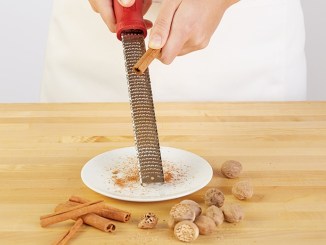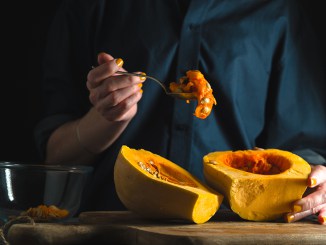
Our snack-friendly culture has embraced edamame, a Japanese bean often eaten like unshelled Southern boiled peanuts. A type of shell bean, edamame contains immature soy beans within each pod that can be served whole and squeezed from one end to release slippery, crisp beans.
Product labels typically designate both whole and shelled forms as edamame, although “eda” means branch and “mame” means the whole pod.
In the Kitchen
Inside furry pods, lime-green edamame beans offer fresh pea and subtle sweet-nutty flavors. Early harvesting, at about 80 percent maturity, results in beans with lower levels of gas-producing oligosaccharides and a sweeter taste.
Most legumes have a chalky, grainy or creamy texture, but edamame beans have a lower starch content and al dente texture, making them less appropriate for some bean recipes. For example, they are not malleable, absorbent or creamy enough for bean dips, purees or as soup thickeners. However, the springy, supple texture of edamame beans invite many culinary options.
Cooked and shelled edamame can be pickled, added to bean, grain or noodle salads, or incorporated into classic dishes such as vichyssoise or guacamole. Warm edamame dishes include appetizers of roasted beans, fritters, dumplings and meals or sides such as pasta primavera, succotash and rice pilaf. Substitute edamame in recipes calling for snap peas, fresh shelled peas or baby lima beans.
To serve whole pods as a snack or appetizer, briefly steam, boil or warm them in a microwave, then season with salt and splashes of tamari or rice vinegar.
Edamame also can be used in recipes, including Sweet Curried Edamame Crunchers and Spicy Edamame Slaw with Orange Dressing.
In the Clinic
Edamame is an excellent source of fiber, magnesium, folate and protein, and a good source of potassium. What sets edamame apart from other legumes are its nine essential amino acids, present in quantities that make it a high-quality protein source. Edamame also is high in lutein and zeaxathin, important nutrients for slowing the progression of macular degeneration.
Because soy is one of the top eight food allergens in the United States, the Food Allergen Labeling and Consumer Protection Act of 2004 requires that packaged foods containing soy that are sold in the U.S. must clearly state the presence of soy in the product.
In 1999, the U.S. Food and Drug Administration approved an authorized health claim for soy, allowing product labels to state that diets low in saturated fat and cholesterol that include 25 grams or more per day of soy protein may reduce the risk of heart disease.
This protein quantity equates to about 1½ cups of shelled edamame, making the fiber content (about 12 grams per cup) an easier selling point for heart-related benefits. In October 2017, the FDA released a statement explaining a proposal to revoke the authorized heart disease health claim due to inconsistent evidence. The health claim may be demoted from authorized to qualified, which requires a lower standard of evidence and will allow manufacturers to continue using the claim with a qualifier explaining the limited evidence.
In Quantity
In the U.S., edamame is primarily available in frozen whole or shelled options; in Japan, it’s seasonally available in more than 200 fresh varieties.
Frozen beans are available in bulk quantities for foodservice institutions to store for several months before simmering in salted water, cooling in ice and refrigerating until ready to use. Some U.S. farmers, particularly in Arkansas, are responding to demand by growing soybean plants specifically to sell as edamame, which could increase options for fresh edamame in the future.












